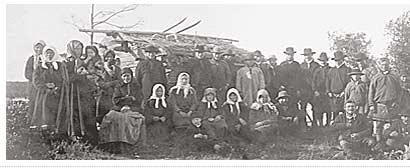

NEW SETTLEMENT
![]()
 |
|||||
 |
|||||
NEW SETTLEMENT
|
|||||
|
|||||
|
|
|
|
|
|
|
|
The yearly move stamped the traditional way of the Inari Sámis settling the Lapp village region. The lands and waters of the Lapp village were the privilege of generations. A new age arrived, however, howbeit slowly. The first pioneer farm was founded by Johan Nilsson Aikio in the 1740s. The village of Kyrö was in its early days a pioneer center which the first Finns who arrived settled together with the Inari Sámis to found new farms. Activity accelerated after the 1830s when Inari Sámis began of their own initiative to build farms around Inari. With the weakening situation of deer hunting and the increase of cattle husbandry, the attempt to secure old rights and tax-free years made the founding of new farms attractive. In all 121 new farms were created in Inari, of which 65,3% were built by Inari Sàmis, other Sámi groups, primarily reindeer Sámis 7,4% and Finns 27,3. Farms were founded in Inari on the basis of traditional Sámi livelihood practices as fields could not be successfully cultivated. The purpose of the national government was stable settlement so authorities could more easily keep an eye on the inhabitants. At the same time it was desirable to get the Sámis within a farming system the same way as elsewhere in the country. When speaking of pioneer farms, a picture of farms
built on common lands belonging to the Crown is often created. In any
case, the dwelling places that the farms were built on were the traditional
homelands of the inhabitants. Their forefathers had made use of the lands
and waters as lands subject to Lapland Tax since time immemorial. Due
to pioneer farming, the traditional uses of the land took on new forms
though their use was very much based on traditional means of livelihood
such as cattle husbandry and fishing, and sometimes reindeer husbandry.
Making a Living Gets Tougher When the Inari Sámi founded a pioneer farm, an abundance of fishing waters was an essential part of the property. Old immemorial fishing waters used by ancestors were regarded by pioneer farmers as their right. As well as privately owned fishing waters joint-use waters were available to villages, if the pioneer farm was formed as part of a group within a village. A major waterway was included as general fishing waters. Inari Sámi fishermen who did not build pioneer farms were allowed rights to private fishing waters and these rights were regarded at least until the mid 1800s as equal to those of pioneer farmers. These rights were passed on from one generation to the next, through marriage between families, they were bought and sold and they could be acquired by life annuity. The first Crown-forest tenant farm in Inari was founded in 1892. As a result of founding them, the number of habitations nearly doubled. At first, these tenant farms already existed as fishing and reindeer herding Sámis' homes that received official status as lands belonging to the crown. Finns also founded such farms. The national government guided home-building towards the founding of Crown-forest tenant farms, because building sufficiently subsistent and large enough farms was not possible in the face of a growing population in Inari. Control of forest use was tightened, wood and lichen harvesting was limited. There was talk of founding Crown parks and forest protection. At the same time the community of Inari was going through a great ferment because of the tightening of control on subsistence. The Finnish population also grew. The migration of reindeer Sámis with greater means and their need for vast areas at their disposal to practice their means of livelihood changed the hierarchy of the area's own Sámi society. The status of the Sámis that had built dwellings in the area, and which the Crown had begun to consider its own, weakened. Forest management authorities attempted in any way possible to keep an exact account of Sámis living on Crown lands. Whenever possible, dwellings that were already present were transformed into Crown-forest tenant farms. A number of reindeer Sámis founded pioneer farms or purchased the same and part received permission to found Crown-forest farms. In practice, building pioneer farms became difficult at the end of the 1800s. When the forest management authorities tried to
separate surplus Crown lands in Inari, incentive was possible financial
gain from use of the forests. After the temporary separation of surplus
lands the State began to sell forest land from Inari and the first general
parceling out of land began in 1911. This forest venture caused the abortion
of distributions in process. A law for general parceling and taxation
in northern communities was created in 1925 and actual parceling was started
in Inari in the 1930s. Crown tenant farms were made into independent farms.
The Second World War put a stop to parceling activities, most of which
were done in the 1950s and 1960s. General parceling changed the division
of the village of Inari as well.
|
| ||||||||||||||
| © 2006 Sámi musea Siida & Anarâškielâ servi siida@samimuseum.fi |